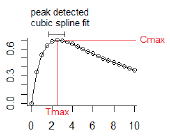Blocks are sets of statements grouped together inside curly brackets. Statements include assignment of values and variables. Statements within the model (and within blocks) can span multiple lines of code, and can be separated with (optional) semicolons.
In the following table:
var is a variable name
varlist is a list of variables, optionally separated by commas
numlist is a list of numbers, optionally separated by commas
assign is an assignment operator
expr is any numerical expression, including variable names, numbers and arithmetic operators
[ …] indicates the content of the brackets is optional
| represents “or” and separates options
* means zero or more of an item can be displayed
+ means one or more of an item can be displayed
statement is a statement of the form: variable=expression
|
Statement |
Purpose |
|
cfMacro(id,parameters, |
Macro-parameter model of concentration, using optional stripping dose. |
|
cfMacro(id,parameters, |
Macro-parameter model of amount in central compartment (cpt). |
|
cfMicro(id,parameters, |
Micro-parameter model. See “One-compartment first-order absorption, closed-form”. |
|
count(var,expr[,action]) |
Defines an occurrence count. |
|
covariate(var(var)*) |
Defines one or more variables as covariates. |
|
delay(expression, |
Models delayed outcomes using convolution of the signal to be delayed (S) and the probability density function (g) of the delay time. |
|
•MeanDelayTime: The value (positive) associated with the mean delay time. |
|
|
•ShapeExpression: The value (positive) representing the shape parameter that defines the distribution of the delay time. |
|
|
•HistExpression: The value of the expression prior to time 0. |
|
|
Any number of delay functions can be included in a model. The MeanDelayTime and shape parameters can be estimated. See also “Discrete and distributed delays”. |
|
|
delayInfCpt(A, |
A statement related to a compartment (that can receive a dose through a dosepoint statement) with all of its input delayed (where the delay time is assumed to be gamma distribution), including the rate of administered dose (if provided) and the inflow specified by the “in” option (if provided). |
|
•A: Name of the compartment. |
|
|
•MeanDelayTime: The value (positive) associated with the mean delay time. |
|
|
•ShapeParamMinusOne: The value (non-negative) representing one less than the shape parameter that defines the distribution of the delay time. |
|
|
•out=outflow: (Optional) Represents the flow out of compartment A. |
|
|
•in=inflow: (Optional) Represents the additional inflow that is delayed. |
|
|
See also “Discrete and distributed delays”. |
|
|
deriv(var assign expr) |
Defines a differential equation. |
|
dosepoint| dosepoint2(id |
Defines dosing. Example: |
|
error(var(var)(*)) |
Defines the error statement. Examples: error(CEps = 0.1) |
|
event(var,expr) |
Defines an unscheduled (e.g., adverse) event, where var is an occur variable, expr is its hazard. |
|
•0=did not occur |
|
|
•1=occurred at the given time |
|
|
•2=occurred at least once in the prior interval |
|
|
•–n=occurred n times in the prior interval |
|
|
•–999999=no information about the prior interval |
|
|
fixef(var[()][ (enable=int)] |
Defines variable(s) as fixed effects parameters, optionally with a fixed value (), with optional initial estimate and bounds. |
|
interpolate(id(id) (*)) |
For more on the interpolate statement, see “Covariates”. |
|
LL(obsvar,expr) |
Defines log-likelihood where obsvar is the observation variable, expr is its log-likelihood. |
|
multi(var,invlink(,expr)*[ ,action]) |
Defines an integer-valued categorical observation, where invlink is an inverse link function and the rest is a series of ascending offset expressions. |
|
observe(id1[ (i d2)] |
Defines predicted observations, where id1 is the Gaussian prediction variable, id2 is the independent variable, and expr is the value assigned to id1. |
|
ordinal(var,invlink,input,slope, (,intercept)*) |
Variation on the multi statement. |
|
Tmax=peak(Cmax=C) |
Use in model code (not in a sequence block, doafter, or dobefore). |
|
peakreset(Cmax) |
Use in a sequence block, doafter, or dobefore. |
|
proc{ statement*} |
|
|
ranef((block(varlist)=numlist)*) |
Defines variable(s) as random effects parameters, optionally defining the covariance matrix. |
|
section(<int>,section-stmt) |
|
|
sequence{ statement*} |
Defines a block of statements to be executed together and can contain conditional statements. It can contain special statements: |
|
•if statements set statements to be executed conditional on expr being true |
|
|
•while statements set zero or more statements to be executed while expr is true |
|
|
•sleep statements pause computations for expr time units. (The expr value for the sleep statement is a relative time, not an absolute time.) |
|
|
See “Modeling discontinuous events”, “One-compartment model with sequence”, and “One-compartment model with sleep statement”. |
|
|
stparm((var | var=expr) +) |
Defines one or more structural model parameters, var, with optional values, expr. |
|
urinecpt(var assign expr) |
Defines an elimination compartment. |

